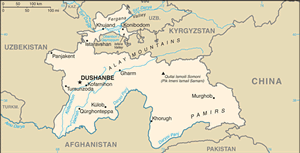The Geography of Tajikistan
The Geography of Tajikistan
Tajikistani Geography
Location: Central Asia, west of China
Geographic coordinates: 39 00 N, 71 00 E
Map references: Asia
Area: total: 143,100 sq km land: 142,700 sq km water: 400 sq km
Area - comparative: slightly smaller than Wisconsin
Land boundaries: total: 3,651 km border countries: Afghanistan 1,206 km, China 414 km, Kyrgyzstan 870 km, Uzbekistan 1,161 km
Coastline: 0 km (landlocked)
Maritime claims: none (landlocked)
Climate: midlatitude continental, hot summers, mild winters; semiarid to polar in Pamir Mountains
Terrain: Pamir and Alay Mountains dominate landscape; western Fergana Valley in north, Kofarnihon and Vakhsh Valleys in southwest
Elevation extremes: lowest point: Syr Darya (Sirdaryo) 300 m highest point: Qullai Ismoili Somoni 7,495 m
Natural resources: hydropower, some petroleum, uranium, mercury, brown coal, lead, zinc, antimony, tungsten, silver, gold
Land use: arable land: 6.52% permanent crops: 0.89% other: 92.59% (2005)
Irrigated land: 7,220 sq km (2003)
Natural hazards: earthquakes; floods
Environment - current issues: inadequate sanitation facilities; increasing levels of soil salinity; industrial pollution; excessive pesticides
Environment - international agreements: party to: Biodiversity, Climate Change, Climate Change-Kyoto Protocol, Desertification, Environmental Modification, Ozone Layer Protection, Wetlands signed, but not ratified: none of the selected agreements
Geography - note: landlocked; mountainous region dominated by the Trans-Alay Range in the north and the Pamirs in the southeast; highest point, Qullai Ismoili Somoni (formerly Communism Peak), was the tallest mountain in the former USSR


